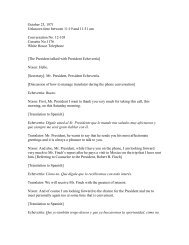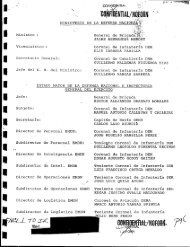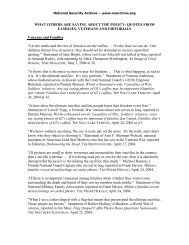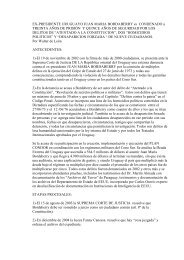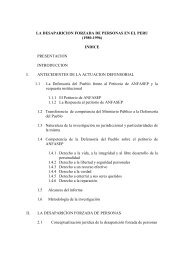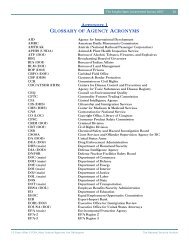TERRORISM 98 - FBI
TERRORISM 98 - FBI
TERRORISM 98 - FBI
You also want an ePaper? Increase the reach of your titles
YUMPU automatically turns print PDFs into web optimized ePapers that Google loves.
APRIL 13, 19<strong>98</strong><br />
Sentencing of Terrell P. "Terry" Coon<br />
On April 13, 19<strong>98</strong>, Terrell P. "Terry" Coon<br />
was sentenced to four years and three months in federal<br />
prison for his role in a plot to bomb an <strong>FBI</strong> fingerprint<br />
complex in Clarksburg, West Virginia.<br />
Federal Judge Frederick P. Stamp of the Northern<br />
District of West Virginia also ordered Coon to serve<br />
three years supervised release after his prison term<br />
and to pay a 10,000-dollar fine.<br />
Coon was one of five people convicted for<br />
plotting to blow up the <strong>FBI</strong>'s Clarksburg fingerprint<br />
facility in 1996. In October 1997, he was convicted<br />
of three counts of illegally transporting explosives<br />
across state lines, as well as two firearms violations.<br />
MAY 15, 19<strong>98</strong><br />
Sentencing of Abdel Hakim Murad<br />
On December 12, 1994, Ramzi Yousef--mastermind<br />
of the February 1993 World Trade Center<br />
bombing--placed a small explosive on Philippine<br />
Airlines Flight 434 en route from the Philippines to<br />
Tokyo, Japan. After Yousef departed the plane on a<br />
layover stop, the device exploded as the plane<br />
approached Japan. The blast killed a Japanese businessman<br />
but failed to down the aircraft.<br />
Investigators later discovered that the explosion<br />
onboard flight 434 was part of a much broader<br />
conspiracy against the United States. Yousef and<br />
three co-conspirators were testing a new bomb design<br />
for a plot to down several U.S. commercial aircraft<br />
transiting the Far East over a two-day period in 1995.<br />
On January 6, 1995, Yousef, Abdel Hakim Murad,<br />
and Wali Khan were mixing chemicals in a Manila<br />
(Philippines) apartment when a fire broke out.<br />
Responding police units arrested Murad at the scene<br />
when they found the explosives-making materials.<br />
Wali Khan was arrested days later, but Yousef successfully<br />
fled the Philippines and ultimately found his<br />
way to Pakistan. He was subsequently apprehended<br />
in Pakistan and rendered to the United States in<br />
February 1995.<br />
On September 5, 1996, a jury in New York<br />
convicted Ramzi Yousef, Abdel Hakim Murad, and<br />
Wali Khan for conspiring to bomb U.S. commercial<br />
aircraft. On January 8, 19<strong>98</strong>, Yousef was sentenced<br />
for his roles in both the World Trade Center bomb-<br />
ing and the plot to bomb the U.S. airliners. (Also on<br />
that date, an indictment for Khalid Shaikh<br />
Mohammed, the fourth named subject in the airliners<br />
plot, was unsealed in the Southern District of New<br />
York.) On May 15, 19<strong>98</strong>, a federal District Court in<br />
New York sentenced Abdel Hakim Murad to life in<br />
prison without parole, plus 60 years, for his role in<br />
the aircraft bombing conspiracy, as well as the death<br />
of the Japanese passenger killed on flight 434. The<br />
judge also fined Murad 250,000 dollars.<br />
By year's end, Wali Khan was awaiting sentencing,<br />
and Khalid Shaikh Mohammed remained a<br />
fugitive.<br />
JUNE 3, 19<strong>98</strong><br />
Rendition of Mohammed Rashid<br />
to the United States<br />
On June 3, 19<strong>98</strong>, international terrorist<br />
Mohammed Rashid was taken into U.S. custody<br />
overseas and rendered to the United States to stand<br />
trial on charges related to the bombing of Pan Am<br />
Flight 830 in 1<strong>98</strong>2. The bombing killed a 16-yearold<br />
Japanese boy and wounded 15 others. Upon his<br />
arrival in the United States, Rashid was arraigned in<br />
U.S. District Court, Washington, D.C., on charges of<br />
murder, aircraft sabotage, explosive offenses, and conspiracy.<br />
Rashid's trial was scheduled to begin in<br />
1999.<br />
JUNE 4, 19<strong>98</strong><br />
Sentencing of Terry Lynn Nichols<br />
On June 4, 19<strong>98</strong>, Terry Lynn Nichols was<br />
sentenced to life in prison for his role in the April<br />
19, 1995 bombing of the Alfred P. Murrah Federal<br />
Building in Oklahoma City. Nichols also was<br />
sentenced to eight, six-year terms concurrently for his<br />
conviction on eight counts of involuntary<br />
manslaughter. U.S. District Court Judge Richard<br />
Matsch imposed the maximum sentence for the conspiracy<br />
and involuntary manslaughter charges of<br />
which Nichols was convicted on December 23, 1997.<br />
On August 14, 1997, Nichols' co-conspirator,<br />
Timothy McVeigh, was sentenced to death by lethal<br />
injection for masterminding and carrying out the<br />
bombing. On May 27, 19<strong>98</strong>, Michael Fortier, who<br />
had become a witness for the government, received a<br />
sentence of 12 years' imprisonment for failing to<br />
warn authorities of the impending plot.<br />
<strong>TERRORISM</strong> IN THE UNITED STATES 19<strong>98</strong><br />
10




